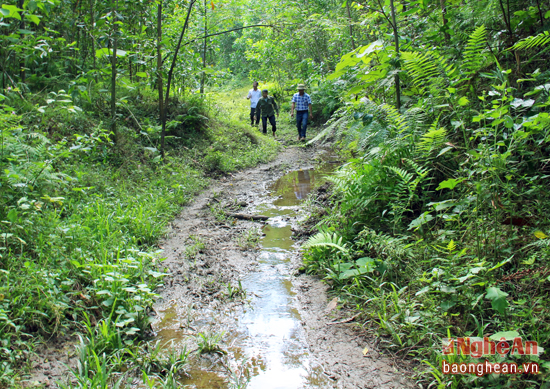(Baonghean.vn) - Farm economy is very important for the socio-economic development of the mountainous people. However, most of the farms here are mainly located in complex terrain, divided by many rivers, streams and rugged mountains. In some highland areas, traffic can only be accessed in the dry season. This makes the care and consumption of crops and livestock from farms extremely difficult. In practice, traffic infrastructure has become a major obstacle to the development of this type of economy.
 |
Giai Xuan is one of the key areas for farm economic development in Tan Ky district. Currently, the whole locality has more than 40 family farms and 10 combined farms. From here, people have gradually eliminated backwardness in economic activities to boldly develop cultivation and livestock farming in the direction of concentrated goods. However, one of the obstacles to the farm economy here is that the traffic system in the commune is still very primitive and cannot meet the traffic capacity of means of transport. In the picture is the road leading to Van Xuan and Van Long hamlets, where there are dozens of hectares of farms of local people. |
 |
| The roads connecting the commune center to the hilly areas are often very narrow and mostly dirt roads. Whether it is sunny or cold season, after a rain, the entire road system becomes slippery and muddy, making it difficult for people and vehicles to move. Especially during the harvest season, transporting dozens of tons of products from the growing area to the outside for consumption is one of the most difficult stages for people. |
 |
| To develop their farms, many people have to open kilometers of roads. In the picture is the farm of Mr. Nguyen Van Huu (born in 1961, Van Xuan hamlet, Giai Xuan, Tan Ky) after nearly 10 years of reclaiming land and digging roads. In that area of more than 6 hectares, he planted fruit trees including dragon fruit, oranges and tangerines. During each harvest, the estimated fruit yield can reach tens of tons. Due to the small roads and difficulties in transportation, it takes weeks to sell all of them. Sometimes, because of the long waiting time for transportation, a lot of fruit is damaged. This is the situation that many people in Giai Xuan in particular and more than 520 farms and ranches in Tan Ky in general are facing. |
 |
| In Chau Ly (Quy Hop), the locality is leading the movement to develop production forests with an area of up to 3,700 hectares of forestry trees, mainly acacia trees. It is estimated that on average, each hectare of acacia yields from 120 to 150 tons of products during the harvest season. To transport the quantity of trees after harvest, people need to mobilize large transport vehicles. However, the traffic system leading to the planting areas is small, difficult and muddy paths, making consumption not easy. In the picture is the newly opened road leading to the forestry farm in the Tom valley of the commune. |
 |
| Mr. Nguyen Duc Binh's farm is nearly 20 hectares wide in Thung Tom (Den village, Chau Ly) and mainly cultivates acacia trees. According to calculations, one truck transports about 10 tons of acacia at a price of about 250,000 VND per ton. In total, each hectare of acacia costs about 30 million VND to transport, accounting for more than 30% of total income. |
 |
| In Dien Lam (Quy Chau), the locality has more than 4,200 hectares of production forest, which is the area of farm enclosures to combine forest planting and livestock development of the people. Here, most of the roads leading to the people's farms are just small trails. In the photo is the farm of Mr. Quang Van Cuong (Co Huong village, Dien Lam). Surrounding Mr. Cuong's farm is a dense system of streams, so transporting trees, seedlings or fertilizers into the farm as well as consuming products is very difficult. |
 |
| With the strength of forest land area, the whole Ky Son district currently has more than 400 models of family farms and comprehensive forest garden farms. However, in addition to the main roads that have been invested in asphalt, the road system running from the commune center deep into the villages and the areas of the people's protected areas is still mostly dirt roads or trails across the rugged mountainous terrain. |
 |
| The local people are mostly Mong, Thai, Kho Mu... with difficult living conditions, so spending money to invest in road construction is impossible. Mr. Cut Bun Ma, in Noong De village, Nam Can commune (Ky Son), after decades of land reclamation, has developed a farm of nearly 19 hectares of livestock farm combined with growing fruit trees and forestry trees. He also had to spend more than 90 million VND out of his own pocket to dig roads and level the ground, but it is still just a drop in the ocean. Currently, Nam Can commune has more than 30 farms and ranches that are in a similar situation. |
 |
| The effectiveness of expanding and developing farms and ranches is obvious to everyone, however, due to the shortcomings of the transport infrastructure, people are still skeptical about investing in and producing livestock. Hopefully, authorities at all levels will have appropriate policies, paying attention to supporting people in special areas to develop the economy and sustainably reduce poverty. |
Thanh Quynh











.jpg)




